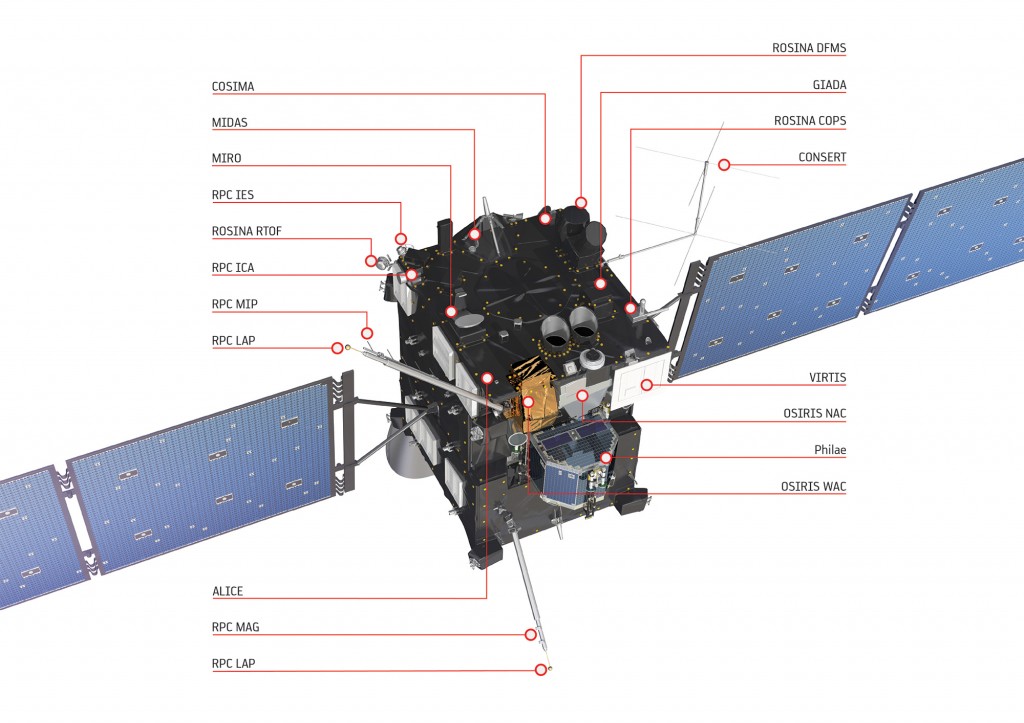Next week we take another step towards performing unique science at a comet: Rosetta’s instruments start to get put through their paces in what is known as the “payload commissioning” period of a mission. Of course, in Rosetta’s case it’s more like re-commissioning, since the instruments have already collected scientific data during the mission’s ten year journey, notably during flybys of Earth, Mars and asteroids Steins and Lutetia.
With 11 experiments to check out – plus the Philae lander – the re-commissioning will last six weeks, during which time Rosetta will have travelled another 3 million kilometres towards comet 67P/Churyumov-Gerasimenko.
While there won’t really be any results to report on from this phase – aside from letting you know that the instruments are ready, and perhaps even a ‘first light’ image from OSIRIS – we thought you’d still like to know how your favourite spacecraft is being kept busy over the coming six weeks.
So, here’s a rough schedule of which instruments are receiving commands each week, followed by a brief one-line description of the science goal of each instrument.
The instruments are listed in alphabetical order for each given week, and not necessarily in the order in which they are being activated.
17-23 March: ALICE, OSIRIS, RPC
24-30 March: ALICE, CONSERT, COSIMA, GIADA, MIDAS, Philae, ROSINA, RPC, RSI
31 March-6 April: ALICE, COSIMA, GIADA, MIDAS, ROSINA, RSI
7-13 April: CONSERT, GIADA, MIDAS, Philae, ROSINA, VIRTIS
14-20 April: CONSERT, Philae, ROSINA, RPC, RSI
21-29 April: CONSERT, MIRO, Philae, RSI
ALICE: Ultraviolet Imaging Spectrometer – (characterising the composition of the comet nucleus and coma)
CONSERT: Comet Nucleus Sounding Experiment by Radio wave Transmission (studying the internal structure of the comet with lander Philae)
COSIMA: Cometary Secondary Ion Mass Analyser (studying the composition of the dust in the comet’s coma)
GIADA: Grain Impact Analyser and Dust Accumulator (measuring the number, mass, momentum and velocity distribution of dust grains in the near-comet environment)
MIDAS: Micro-Imaging Dust Analysis System (studying the dust environment of the comet)
MIRO: Microwave Instrument for the Rosetta Orbiter (investigating the nature of the cometary nucleus, outgassing from the nucleus and development of the coma)
OSIRIS: Optical, Spectroscopic, and Infrared Remote Imaging System Camera (a dual camera imaging system consisting of a narrow angle (NAC) and wide angle camera (WAC) and operating in the visible, near infrared and near ultraviolet wavelength range)
ROSINA: Rosetta Orbiter Spectrometer for Ion and Neutral Analysis (determining the composition of the comet’s atmosphere and ionosphere, and measuring the temperature, velocity and density of the gas flow, comprising: DFMS (Double-Focusing Mass Spectrometer), RTOF (Reflectron Time-Of-Flight mass spectrometer) and COPS (Comet Pressure Sensor))
RPC: Rosetta Plasma Consortium (studying the plasma environment of the comet, comprising: ICA (Ion Composition Analyser), IES (Ion and Electron Sensor), LAP (Langmuir Probe), MAG (Fluxgate Magnetometer), MIP (Mutual Impedance Probe), PIU (Plasma Interface Unit))
RSI: Radio Science Investigation (tracking the motion of the spacecraft to infer details of the comet environment and nucleus)
VIRTIS: Visible and Infrared Thermal Imaging Spectrometer (studying the nature of the comet nucleus and the gases in the coma)










Discussion: 9 comments
I really like that type of technical Information, even if there’s no spectacular news. Please proceed like this.
Excellent post! Thanks! Looking forward to an OSIRIS first light pic as well as operational confirmation on the other instruments. Exciting times ahead!
Very informative! Thanks very much for these detailed up-dates! Nice to see how much work & planning is needed to do this mission. Keep up the good work!
Any news? Has the re-commissioning started?
Thanks
Steve
Hi Steve, yes, as per the outline the commissioning started earlier this week.
That’s great. Keep us informed, Steve
Herzlichen Dank für die Infos.
Auch so kann man englisch lernen.
Weiter so.
I enjoy a lot your information. Thank you very much!
I wonder if there will be preliminary data from the RPC instruments available? Or will we have to wait until actually submits a paper for peer review?
Thanks!
Alexander.